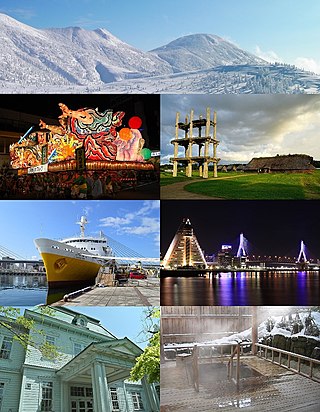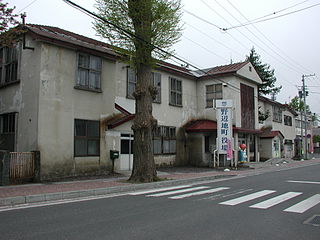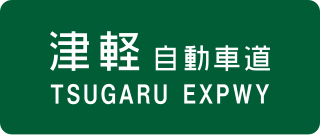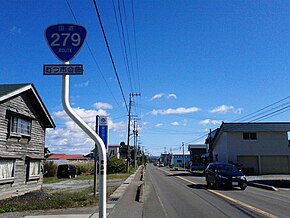
Aomori, officially Aomori City, is the capital city of Aomori Prefecture, in the Tōhoku region of Japan. As of 1 August 2023, the city had an estimated population of 264,945 in 136,781 households, and a population density of 321 people per square kilometer spread over the city's total area of 824.61 km2 (318.38 sq mi). Aomori is one of Japan's 62 core cities and the core of the Aomori metropolitan area.

Aomori Prefecture ([a̠o̞mo̞ɾʲikẽ̞ɴ]) is a prefecture of Japan in the Tōhoku region. The prefecture's capital, largest city, and namesake is the city of Aomori. Aomori is the northernmost prefecture on Japan's main island, Honshu, and is bordered by the Pacific Ocean to the east, Iwate Prefecture to the southeast, Akita Prefecture to the southwest, the Sea of Japan to the west, and Hokkaido across the Tsugaru Strait to the north. Aomori Prefecture is the 8th-largest prefecture, with an area of 9,645.64 km2 (3,724.20 sq mi), and the 31st-most populous prefecture, with more than 1.18 million people. Approximately 45 percent of Aomori Prefecture's residents live in its two core cities, Aomori and Hachinohe, which lie on coastal plains. The majority of the prefecture is covered in forested mountain ranges, with population centers occupying valleys and plains. Aomori is the third-most populous prefecture in the Tōhoku region, after Miyagi Prefecture and Fukushima Prefecture. Mount Iwaki, an active stratovolcano, is the prefecture's highest point, at almost 1,624.7 m (5,330 ft).

Mutsu is a city located in Aomori Prefecture, Japan. As of 31 January 2023, the city had an estimated population of 53,804 in 28553, and a population density of 62 persons per km2. The total area of the city is 864.12 square kilometers (333.64 sq mi), making it the largest municipality in Aomori Prefecture in terms of area.

Yokohama is a town located in Aomori Prefecture, Japan. As of 1 March 2023, the town had an estimated population of 4,258 in 2134 households, and a population density of 33 persons per km2, in 1,779 households. The total area of the town is 126.38 square kilometres (48.80 sq mi).

Noheji is a town located in Aomori Prefecture, Japan. As of 28 February 2023, the town had an estimated population of 12,249 in 6313 households, and a population density of 150 persons per km2. The total area of the town is 81.68 square kilometers (31.54 sq mi).

Ōma is a town located in Aomori, Japan. As of 31 January 2023, the town had an estimated population of 4,868 in 2500 households, and a population density of 93 per square kilometre (240/sq mi). The total area of the town is 52.10 square kilometres (20.12 sq mi).
National Route 4 is a major national highway in eastern Honshū, Japan. Measuring 738.5 kilometers long (458.9 mi), it is the longest highway in the country. When oversea routes are included, it is the second longest highway in Japan, with National Route 58 then measuring 884.4 kilometers (549.5 mi) because of its maritime sections. The highway connects Tokyo and Aomori via Utsunomiya, Kōriyama, Sendai, and Morioka.

Mutsu Bay is a bay located within Aomori Prefecture, in the northern Tōhoku region of northern Japan. It has an east-west distance of approximately 40 kilometers and a north-south distance of approximately 40 kilometers at its eastern end, with a total area of approximately 1,667.89 square kilometers.

The Ōminato Line is a railway line operated by East Japan Railway Company. It connects Noheji Station and Ōminato Station on the Shimokita Peninsula in eastern Aomori Prefecture.
National Route 45 is a national highway of Japan connecting Aoba-ku, Sendai and Aomori, Aomori. Alongside Japan National Route 6, it is a main route along the Pacific coast of eastern Japan. It is paralleled closely by the incomplete Sanriku Expressway between Sendai and Hachinohe.
National Route 101 is a national highway of Japan connecting the capitals of Aomori and Akita prefectures, Aomori and Akita in northern Japan, with a total length of 241.6 kilometers (150.1 mi). The majority of the highway travels along the coast of the Sea of Japan, paralleling the more inland National Route 7. The present-day highway largely follows the path of the Ōmagoe-kaidō, an Edo period road that linked the Kubota and Hirosaki feudal domains.

National Route 280 is a national highway of Japan that traverses the prefectures, Aomori and Hokkaido as well as the Tsugaru Strait that separates them. It currently is made up of two sections that travel 150.7 kilometres (93.6 mi) from Aomori, north across the Tsugaru Peninsula to Sotogahama where the first section ends at the site of a former ferry to across the Tsugaru Strait to the town, Fukushima. The other section begins at the corresponding former ferry terminal in Fukushima. The road then travels alongside the southern coast of Hokkaido concurrently with National Route 228 to Hakodate where the route meets its northern terminus.

National Route 338 is a national highway in the Japanese prefectures of Hokkaido and Aomori. Route 338 stretches 241.3 kilometers (149.9 mi) from National Route 5 in Hakodate, Hokkaido south across the Tsugaru Strait by ferry to Ōma, Aomori, around the western, southern, and eastern edges of the Shimokita Peninsula and finally to Oirase.
National Route 339 is a national highway of Japan that traverses the western side of Aomori Prefecture, traveling south to north. The 108.4-kilometer (67.4 mi) highway begins as a concurrent route with National Route 7 in central Hirosaki, it then leaves National Route 7 in Fujisaki and travels north through the municipalities of Itayanagi, Tsuruta, Goshogawara, and Nakadomari before ending at an intersection with National Route 280 in Sotogahama. In a unique feature, a 0.4-kilometer-long (0.25 mi) section of the route on Cape Tappi is a staircase.

National Route 394 is a national highway in the Japanese prefecture of Aomori. Route 394 stretches 185 km from National Routes 279 and 338 in Mutsu southwest to National Route 7 in Hirosaki.

The Michinoku Toll Road is a two-lane toll road in Aomori Prefecture connecting the cities Aomori and Hachinohe via Shichinohe. It serves as an alternative to Japan National Route 4, bypassing the towns Hiranai and Noheji by cutting directly through the Hakkōda Mountains and other mountains of the northern Ōu Mountain Range. The road is managed by the Aomori Prefecture Road Corporation and is numbered E4A as an extension of the Tōhoku Expressway.

The Tsugaru Expressway is a two-lane national expressway in Aomori Prefecture, Japan. The expressway connects the prefecture's capital, Aomori, and the Tōhoku Expressway to the municipalities of Goshogawara, Tsugaru and, Ajigasawa. It is owned and operated by Ministry of Land, Infrastructure, Transport and Tourism and is signed as an auxiliary route of National Route 101 as well as E64 under their "2016 Proposal for Realization of Expressway Numbering."

The Shimokita Expressway is a two-lane national expressway in Aomori Prefecture, Japan. The expressway connects Noheji to the municipalities of Rokkasho, and Yokohama. It is owned and operated by Ministry of Land, Infrastructure, Transport and Tourism (MLIT), and is signed as an auxiliary route of National Route 279, but has no expressway number under their "2016 Proposal for Realization of Expressway Numbering."

The Tsugaru Kaikyō Ferry is a privately owned ferry service crossing the Tsugaru Strait, which separates Hokkaido from Honshu. The ferries run three routes: Hakodate to Aomori and Hakodate to Ōma, Muroran to Aomori.
The Tanabu Kaidō (田名部街道) is a road in eastern Aomori Prefecture that connects the town of Noheji in the south, to the city of Mutsu to the north. It was established by the Nanbu clan as an extension of the Matsumaedō a sub-route of the Ōshū Kaidō, one of the five routes established by Tokugawa Ieyasu for traveling government officials during the Edo period.



















